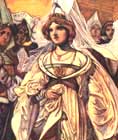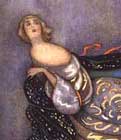
Cinderella:
345 Variants
by Marian
Roalfe Cox
SurLaLune's
Cinderella Area
SurLaLune Fairy Tales Main Page
235
Frere, M., Old Deccan Days (2nd ed.). Collected from oral tradition. London, 1870. Pp. 236-45. (Narrated by Anna Liberata de Souza, ayah.)
"SODEWA BAI."
[You can read Frere's Sodewa Bai on SurLaLune.]
ABSTRACT
Gems fall from heroine's (Sodewa's) lips. Her soul is contained in necklace--Lost shoe--Hunting prince finds shoe in jungle; seeks owner--Happy marriage--Prince's first wife hates heroine; plots with servant to steal her necklace, so that she dies. Thief does not wear necklace at night; then heroine's soul returns. Prince sees jewels that have fallen from her lips. She bears a son, but dies as day dawns, and babe weeps. Prince visits tomb at night, hears babe cry, and sees heroine; he learns theft. Necklace is restored--Villain Nemesis.
TABULATION
(1) Rajah and Ranee had beautiful daughter, so good that gems fell from her lips when she spoke, whereby father became richest Rajah.-- (2) She was born with golden necklace, which contained her soul,1 so she would die if it were taken off and worn by another.-- (3) One day father gave her slippers of gold and gems, of which one fell into jungle below mountain, while she gathered flowers, and was lost, although great reward offered.-- (4) Prince Rowjee, when hunting, found it, and his mother advised him to seek its owner.-- (5) News reached him about its loss, and his mother advised him to take it to princess, and claim her hand as reward, which was granted.-- (6) Rajah gave him leave to visit his own people, taking his wife, and charged him never to let necklace be taken off her.-- (7) Rowjee had another wile, whom he married in childhood; she hated Sodewa Bai, but feigned love.-- (8) One day Rowjee went a journey, then the first wile went to Sodewa, saw her jewels, and asked why she always wore necklace. Sodewa told her, and the other plotted with servant to steal the necklace, which was done while Sodewa slept, and her spirit fled.-- (9) Next morning Rajah and Ranee found her lying cold as marble; full of grief; they put her in a tomb near a tank, and went daily to look at her body, which kept sweet and fair. Rowjee was sorely grieved on his return, so that all thought he would die.-- (10) The servant did not wear necklace at night; then Sodewa's soul returned, and she walked to the tank to drink, jewels falling from her as she went.-- (11) One day Rowjee, watching, saw these, and stayed to see whence they came, but Sodewa came not.-- (12) After two months she bore a son, but as day dawned she died, and the baby wept.-- (13) Then Rowjee went to tomb at night, heard child cry, saw door open, and Sodewa carry babe to tank. She heard footsteps and fled to tomb; Rowjee followed; called her by name, then she knew him, and told him of theft of necklace.-- (14) He went to palace; summoned servants; saw thief; and sent her to prison.-- (15) She told all; then the first wife was imprisoned for life, and Rowjee went to tomb, put necklace on Sodewa, and brought her and the child to palace.
NOTES
Note 25
(P. 216.) For instances of the external soul in folk-tales, cf. Arnason, 456, 518 (life-egg of the two trolls); Asbjörnsen og Moe, Norske Folkeeventyr, Nos. 36, 70; A. Bastian, Die Völker des ostlichen Asien, iv, 340; Busk, F.-L. R., 164, 168; Campbell, i, 10, 80; Castren, Ethnologische Vorlesungen uber die altaischen Volker, p. 173; Finnish Mythology, p. 186 (story of a giant who kept his soul in a twelve-headed snake, which he carried in a bag as he rode on horseback); Clouston, Pop. Tales and Fictions, i, 347 ff.; A Group of Eastern Romances and Stories, p. 30; Cosquin, i, 173 ff.; Cox, Aryan Myth., ii, 36, 330; Dasent, "The Giant who had no Heart in his Body," p. 55; Tales from the Fjeld, p. 229; Day, Lal Behari, Folk-tales of Bengal, pp. 1, 85, 117, 121, 189, 253; Dietrich, Russian Pop. Tales, p. 23; Dozon, p. 132; Folk-lore Rec., ii, 220 (in skein of silk); F.-L. Journal, ii, 289 ff., "The Philosopsy of Punchkin," by Ed. Clodd; Frere, O. D. D., "Punchkin," p. 12, "Sodewa Bai," "Chundum Rajah," "Truth's Triumph," p. 233; "Wanderings of Vicram Maharajah"; Gonzenbach, No. 16, and ii, 215; Baring Gould, Curious Myths, ii, 299-302 (a Siberian tale about seven robbers whose hearts were hung up on pegs, and are stolen by a captive swan-maiden on which condition her dress is returned to her by the Samsjed who had taken possession of it. He smashes six hearts, and makes the seventh tubber deliver up his old mother's soul, and then kills him also); Gubernatis, Z. M., i, 168; Hahn, i, 187, 217; ii, 23, 204, 215, 260, 275, 282, 294; Haltrich, No. 34, p. 149; Ind. Antiquary (1872), i, 117, 171, and (1885), p. 250; Jamieson, Dict. of the Scottish Language, s. v. "Yule"; Kirby, New Arabian Nights, "Joadar of Cairo and Mahmood of Tunis"; Knowles, Folk-tales of Kashmir, pp. 42, 49, 73, 134, 382; Krauss, i, 168, No. 34; Lane, Arabian Nights, iii, 316, "Seyf-el-Mulook"; Leitner, The Languages and Races of Dardistan, p. 9; Legrand, p. 191; Luzel, i, 445-9; Magyar Folk-tales, pp. 205, 326, 373, 400; Mannhardt, Germanische Mythen, p. 592; Maspero, Contes pop. de l'Egypte ancienne, p. 5 ff., "The Two Brothers" (written down in the reign of Rameses II, circa 1300 B.C.); Mijatovics, i (Denton, p. 172); Müllenhoff, p. 404; Pentamerone, ii, p. 60 (Liebrecht); Radloff, Proben der Volkslitteratur der turkischen Stamme Sud-Sibiriens, i, 345; ii, 237, 531; iv, 88; Ralston, R. F. T., "Koshchei the Deathless," p. 103, and pp. 109, 113, 114; Rivière, Contes Kabyles, p. 191; Schiefner, Heldensagen der Minussinschen Tataren, pp. 108-112, 172-176, 189-193, 360-364, 384, 390, ff.; Sagas from the Far East, p. 130, "Bright Intellect"; Schott, "Ueber die Sage von Geser Chan," Abhandlungen d. Konigl. Akad. D. Wissensch. zu Berlin, 1851, p. 269; Sebillot, Haute Bretagne, p. 63; Spitta-Bey, No. 2, p. 12; Stokes, "Brave Hirálálbásá," "The Demon and the King's Son," pp. 58, 187; Strackerjan, Aberglaube und Sagen, Oldenburg, ii, 306; Sundermann, Allgemeine Missions-Zeitschrift, xi, (1884), p. 453, "Die Insel Nias"; Webster, p. 83; Wide-Awake Stories, pp. 52, 58, 64, 83; Wilken, De Gids, 1888, No. 5, p. 6 (of the separate reprint), "De Simsonsage" (a Malay poem); Wolf No. 20, p. 87; Wratislaw, p. 225.
Compare the story of Meleager and the fire-brand (Apollodorus,
i, 8; Diodorus, iv, 34; Pausanias, x, 31, 4; Aeschylus, Choeph.,
604, ff.); the fatal hair on the head of Nisus (Apollodorus, iii, 15,
8; Aeschylus, Choeph., 612; Pausanias, i, 19, 4). According to
Tzetzes (Schol. on Lycophron, 650), not the life, but the strength
of Nisus was in his hair (compare the Samson story, Judges, xvi, 4-20).
According to Hyginus (Fab. 198), Nisus was destined to reign only
so long as he kept the purple lock on his head. Poseidon made Pterelaus
immortal by giving him a golden hair on his head. His daughter fell in
love with Amphitryon, the enemy of Pterelaus, and killed her father by
pulling out the golden hair (Apollodorus, ii, 4, 5, 7). Sylvia, wife of
Septimius Marcellus, bore a son to the god Mars, who bound up the fate
of the child in a spear (Plutarch, Parallela, 26). See Frazer,
The Golden Bough, ii, 305-308.
The nearest approach to tales similar to these in the Buddhist Birth-stories is in one or two isolated cases, when the Karma of a human being is spoken of as immediately transferred to an animal. (See Mr. Clodd's Myths and Dreams, and Mr. Frazer's Golden Bough, for an exhaustive treatment on the subject of the external soul). Compare the Annamite Stories (Nos. 68, 69, of this collection) in which the life of the heroine is successively transferred to a turtle, a bamboo-shoot, a bird, a tree, etc. There are similar incidents in No. 231. The Zuni Indians of New Mexico, as well as the Moquis, believe in the transmigration of human souls into the bodies of turtles. See "My Adventures in Zuni," by Mr. Cushing, in The Century, May 1883, p. 4 ff.; Schoolcraft, Indian Tribes, iv, 86; Bourke, Snake-Dance of the Moquis of Arizona, pp. 116 ff., 334 ff., and Frazer, op. cit., ii, 99.
Many people believe that a portrait contains the soul of the person portrayed. Thus the Canelos Indians of S. America think their soul is carried away in their picture (Simson, "Notes on the Jivaros and Canelos Indians," Journ. Anthrop. Inst., ix, 392). When Mr. Joseph Thomson tried to photograph some of the Wa-teita in East Africa, they imagined he was trying to get possession of their souls (Thomson, Through Masai Land, p. 86). An Indian refused to let himself be drawn, believing it would cause his death (Maximilian Prinz zu Wied, Reise in das Innere Nord-Amerika, i, 417; see also ii, 166). Some old women in the Greek island of Carpathus were very angry at being drawn, fearing they would in consequence die (Blackwood's Magazine, Feb. 1886, p. 235). Some people in Russia object to having their silhouettes taken lest they die (Ralston, Songs of the Russian People, p. 117). Persons in the West of Scotland refuse to have their likenesses taken (James Napier, Folk-lore; or, Superstitious Beliefs in the W. of Scotland, p. 142; and cf. Andree, Ethnographische Parallelen und Vergleiche, Leipzig, 1889, p. 18 ff.). See Frazer, i, 148-9. Allied to this belief is the practice of pricking the waxen figure of one's enemy.
Compare the story in Schimpf und Ernst, cap. 272 (from the Gesta Romanorum). Sticking needles into a wax figure occurs in Kemble's Chartoe, Pref., lix, lx, and in a story in Müllenhoff, p. 233. Magic figures can also be baked of dough or lime, and wrought out of metal (see Grimm, T. M., 1092). In Pulci's Morgante, 21, 73, a witch's vitality is bound up with a wax figure. When Malagigi melts it at a slow fire, she dwindles away. This kind of conjuring is found in Ovid (Amor., iii, 7, 29). Comp. Horace, Epod., 17, 76. Theocritus, 2, 28, has the wax-melting. In Virgil, Ecl., 8, 74 seq., a magic figure seems to be made of lime and wax.
In evidence of the belief (at least on the part of a hypnotised
subject) in the transference of sensibility from the human body to an
inanimate object, I may refer to the recent (Oct. 1892) experiments in
hypnotism conducted at the Charite hospital by Dr. Luys. He has been able
to transfer a woman's sensibility into a tumbler of water, which retains
it for a considerable time. If the water is drunk before the sensibility
is exhausted the patient (who has not witnessed the occurrence) falls
into a deadly swoon. Also, if the water is touched the hypnotised person
starts as if in pain. Dr. Luys was also able to confirm the discovery
made by Colonel Roche, Administrator of the École Polytechnique,
who found that it was possible to transfer the sensibility of a hypnotised
person to the negative of a photograph of the subject, who not only felt,
but showed signs of, any mark made on the negative. A pin-scratch on the
negative--previously charged with sensibility--causes the appearance of
a similar mark on the subject, etc., etc. One would like to know the effect
upon the subject of throwing the negative into the fire.
Return to place in text.
Cox, Marian Roalfe. Cinderella: Three Hundred and Forty-five Variants of Cinderella, Catskin, and Cap O' Rushes, abstracted and tabulated. London: David Nutt for the Folklore Society, 1893.
While the original text of this book is out of copyright, the special formatting and compilation available on SurLaLune Fairy Tales is copyrighted. Be aware that while the original content has been honored, page numbering, footnote numbering, redesigned charts, links, and other aspects are unique to this site's version of the text. Use at your own risk. For private and fair use educational purposes only.
©Heidi
Anne Heiner, SurLaLune Fairy Tales
E-mail: surlalune@aol.com
Page last updated February 1, 2006
www.surlalunefairytales.com










